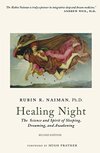
Saved by Anna and
Healing Night: The Science and Spirit of Sleeping, Dreaming, and Awakening

Saved by Anna and
Half-awake in our sleep and half-asleep in our waking, we are never completely at rest and seldom fully conscious.
Storytelling may be the most common evening activity across cultures.
Take part of a day, a full day, or even a long weekend to experiment with resynchronizing with your inner clock.
Sleep is not a place that we can intentionally access.
Taking twenty or thirty minutes to gradually slip into sleep after the lights go out is perfectly natural and healthy.
our reluctance to deal directly with our essential fear of darkness is the major impediment to our rapprochement with night, sleep, and dreams. Accessing the healing power of night requires that we engage in shadow work. And we will get dirty. Healing
Darkness drives us inward where we are confronted with disowned aspects of our psychological selves, our own shadow.
Dusk also encourages community—a kind of social huddling. People universally come together at night for safety and support.
Resuming activity diverts attention from our discomfort and reinforces the mistaken sense that we felt bad either because we were resting or because we simply should have kept moving.